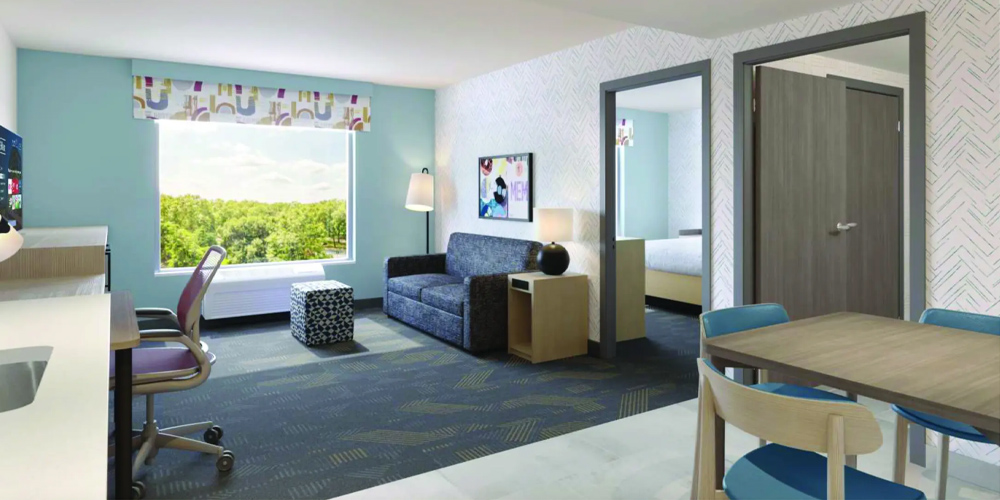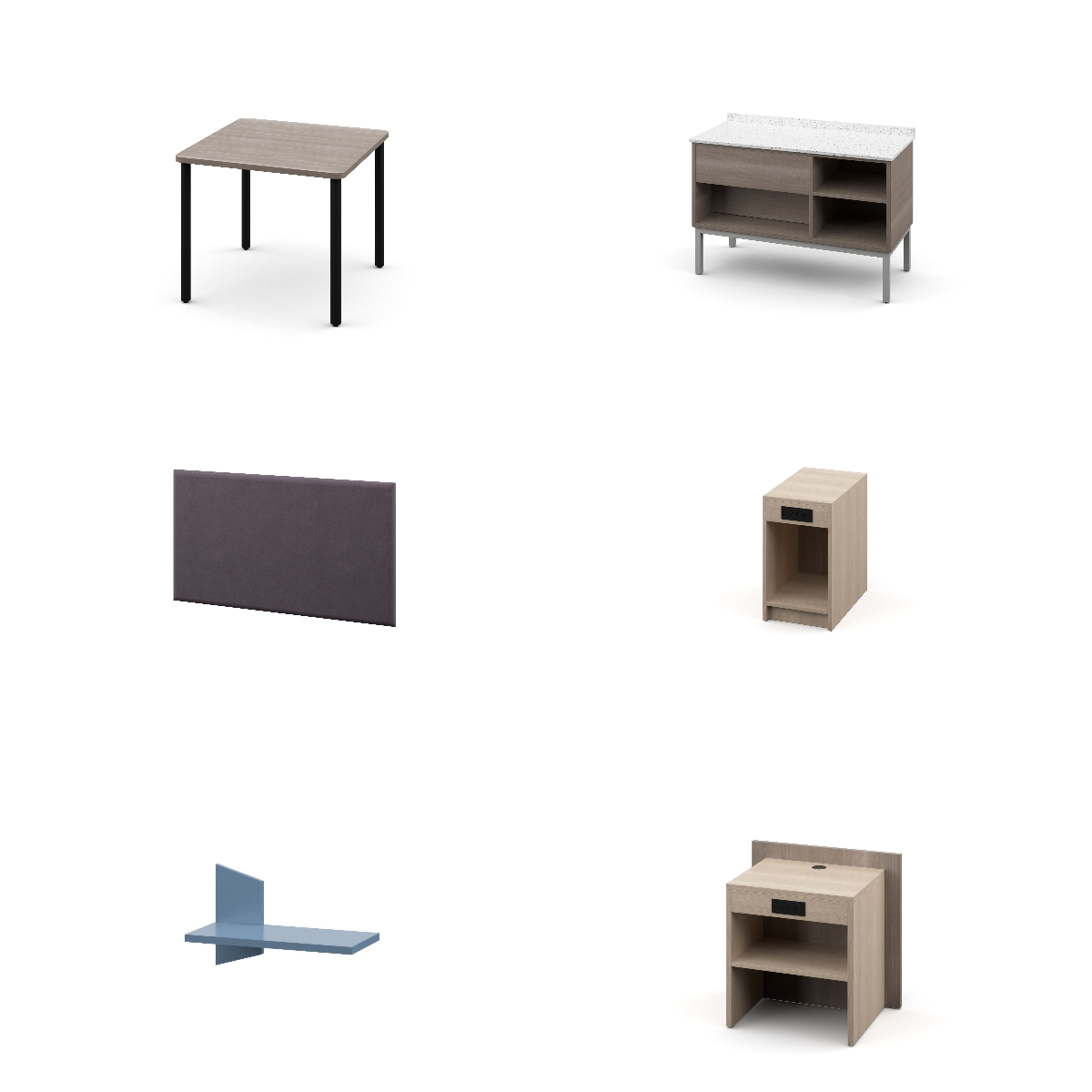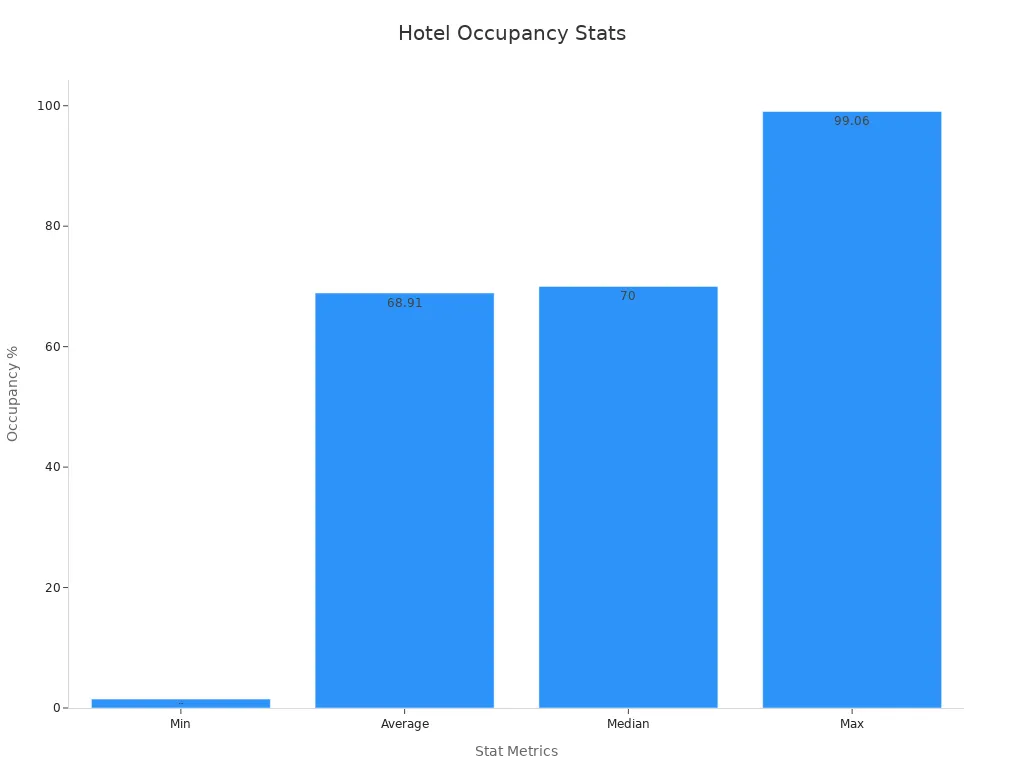
Commercial-grade wood furniture transforms hotel spaces in 2025. Hotels see longer furniture lifespans and less waste. Flexible payment terms help hotels invest in quality. Many hotels choose sustainable options and regular maintenance. These choices lift guest satisfaction and boost brand loyalty. Hotels feel proud to offer comfort, style, and operational efficiency.
Key Takeaways
- Commercial-grade wood furniture uses strong, durable woods like teak and mahogany, advanced joinery, and reinforced construction to last longer and handle heavy hotel use.
- Protective finishes and safety certifications keep furniture looking new, resist damage, and ensure guest safety, reducing maintenance and replacement costs.
- Hotels benefit from customizable, sustainable wood furniture that fits their brand, supports eco-friendly goals, and offers great long-term value compared to residential furniture.
Commercial-grade Wood Furniture: Quality and Construction

Premium Wood Selection
Hotels in 2025 choose premium woods to create lasting impressions and ensure durability. Teak and mahogany stand out as top choices for commercial-grade wood furniture. Each wood type brings unique strengths to hotel environments. Teak offers natural oils that resist water and insects, making it ideal for high-traffic areas and outdoor spaces. Mahogany provides a rich, luxurious look and works well for indoor settings. The following table highlights the differences between these two popular woods:
| Aspect | Teak | Mahogany |
|---|---|---|
| Color | Golden-brown to amber | Reddish-brown to deep red |
| Grain Pattern | Straight with occasional waves | Straight and consistent |
| Natural Oil Content | High (water/insect resistance) | Low (needs protective treatment) |
| Hardness (Janka Rating) | 1,000-1,155 lbf | 800-900 lbf |
| Density | Higher (41 lbs/cubic foot) | Lower (34 lbs/cubic foot) |
| Weather Resistance | Excellent | Good (needs treatment) |
| Insect Resistance | Excellent | Moderate |
| Moisture Absorption | Very low | Moderate |
| Expected Lifespan | 15-25 years | 10-15 years |
| Maintenance Frequency | Annual cleaning, occasional oiling | Quarterly cleaning, refinishing |
Hotels like Ritz-Carlton Bali and Shangri-La Singapore have reduced maintenance costs by choosing the right wood for each space. Teak’s durability and low upkeep make it a favorite for outdoor and busy indoor areas. Mahogany’s beauty and workability shine in luxury suites and lobbies.
Market research shows that hotels now seek sustainable, durable, and beautiful furniture. Premium solid woods like teak and mahogany help hotels boost guest satisfaction and support eco-friendly goals. These choices drive positive reviews and help hotels stand out in a competitive market.
Advanced Joinery Techniques
Craftsmanship plays a vital role in the strength and beauty of commercial-grade wood furniture. Skilled artisans use advanced joinery methods to create pieces that last for years. Mortise and tenon joints, dovetail connections, and reinforced dowels ensure each piece remains sturdy under heavy use. These techniques prevent wobbling and extend the life of furniture in busy hotel settings.
Hotels benefit from this attention to detail. Guests notice the solid feel and smooth finishes. The Home 2 hotel bedroom furniture set by Taisen uses these advanced methods to deliver both style and reliability. Custom joinery allows for unique designs that match each hotel’s brand and vision.
Reinforced Build Standards
Commercial-grade wood furniture must meet strict build standards to perform in demanding environments. Manufacturers follow rigorous guidelines to guarantee strength, safety, and longevity. The following table lists key ASTM standards that support reinforced construction:
| ASTM Standard Code | Description | Relevance to Reinforced Build Standards |
|---|---|---|
| ASTM D6570-18a(2023)e1 | Mechanical grading for lumber | Ensures strength and quality control |
| ASTM D3737-18(2023)e1 | Laminated timber strength | Supports reinforced timber components |
| ASTM D5456-24 | Composite lumber evaluation | Verifies structural applications |
| ASTM D4761 | Mechanical testing methods | Confirms strength and durability |
| ASTM D7199-20 | Reinforced timber beam design | Supports mechanics-based values |
| ASTM D7341-21 | Flexural strength testing | Critical for reinforced parts |
| ASTM D5457-23 | Load and resistance design | Calculates resistance and capacity |
| ASTM D2555-17a(2024)e1 | Clear wood strength values | Assures quality |
| ASTM D1990-25 | In-grade testing for lumber | Ensures structural integrity |
| ASTM D245-25 | Structural grades for lumber | Guarantees consistent quality |
| ASTM D3043-17(2025) | Flexural strength of panels | Tests structural panels |
| ASTM D2719-19 | Shear testing for panels | Measures durability |
| ASTM D5651-21 | Surface bond strength | Critical for laminated parts |
| ASTM D6643-01(2023) | Corner impact resistance | Ensures durability in use |
Manufacturers like Taisen use these standards to deliver furniture that stands up to daily wear and tear. Hotels trust these reinforced build practices to protect their investment and provide guests with safe, comfortable spaces.
Commercial-grade wood furniture sets a new standard for hotels in 2025. Strong materials, expert joinery, and reinforced construction help hotels create welcoming environments that last for years.
Commercial-grade Wood Furniture: Durability and Longevity
Protective Finishes and Coatings
Protective finishes and coatings give hotel furniture its lasting power. These finishes shield wood from spills, scratches, and daily cleaning. Manufacturers use advanced coatings that bond tightly to the wood surface. This strong adhesion keeps finishes from peeling or flaking, even after years of use.
Laboratory tests show how well these finishes perform:
- Adhesion ratings reach 3B to 4B on the ASTM D3359 scale after a full week of curing.
- Pencil hardness tests rate the coatings at 2H or higher, proving resistance to scratches.
- Blush resistance and chemical resistance tests confirm that finishes stand up to moisture and cleaning agents.
- Water repellency tests show at least 60% efficiency, keeping wood dry and stable.
- Blister resistance and dry time checks ensure finishes stay smooth and practical.
Researchers also test finishes with tape, heat, and moisture. They use southern yellow pine wood and simulate tough hotel conditions. These tests prove that coatings stay flexible, resist cracking, and hold up under stress. Long-term outdoor exposure studies in places like Charlotte, NC, show that finishes keep their gloss and resist mildew for years.
Coating penetration matters, too. When finishes soak into the wood, they create a strong bond. This bond helps prevent cracks and keeps the wood looking new. The right film thickness boosts abrasion resistance and keeps finishes in place. Hotels that choose furniture with these advanced coatings see fewer repairs and longer-lasting beauty.
Resistance to Wear and Tear
Hotel furniture faces constant use. Guests move chairs, open drawers, and set down heavy bags every day. Commercial-grade wood furniture stands up to this challenge. Manufacturers design each piece to handle bumps, scratches, and spills without losing its charm.
They use strong materials like MDF, plywood, and engineered woods. These materials resist dents and chips better than standard wood. Reinforced joints and sturdy hardware add extra strength. Finishes protect surfaces from stains and fading, even in sunny rooms or busy lobbies.
Hotel managers often share stories of furniture that looks new after years of service. They credit the tough finishes and solid construction. Guests notice the difference, too. They feel confident and comfortable in rooms with furniture that stands the test of time.
Compliance with Safety Codes
Safety always comes first in hotels. Commercial-grade wood furniture must meet strict safety codes. Manufacturers follow rules for fire resistance, chemical safety, and structural strength. They test finishes for flame spread and smoke production. Only coatings that pass these tests make it into hotel rooms.
Furniture also needs to resist stains and impacts. Industry standards require surfaces to withstand spills from coffee, wine, and cleaning products. Impact tests make sure corners and edges stay safe and smooth. Many manufacturers seek certifications from groups like ASTM and ANSI. These certifications prove that furniture meets or exceeds industry standards.
A table of common safety codes for hotel furniture:
| Safety Code | Focus Area | Importance for Hotels |
|---|---|---|
| ASTM E84 | Fire resistance | Limits flame spread |
| ANSI/BIFMA X5.5 | Structural safety | Ensures strength and stability |
| ASTM D1308 | Chemical resistance | Protects against stains |
| ASTM D256 | Impact resistance | Prevents breakage |
Hotels that choose certified furniture protect guests and staff. They also reduce liability and build trust with visitors. Safety and durability go hand in hand, creating spaces where everyone feels secure.
Commercial-grade Wood Furniture: Design and Customization

Adaptable Styles for Hotel Environments
Hotels need furniture that fits many different spaces and moods. Commercial-grade wood furniture brings natural warmth and comfort to every room. Designers choose wood because it creates inviting atmospheres and helps guests feel relaxed. Studies show that wood elements in hotel interiors can reduce stress and improve well-being. This makes wood a smart choice for hotels that want to offer a welcoming experience.
Market trends reveal a strong demand for versatile and modular furniture. Hotels often select pieces that can be reconfigured or moved to suit changing needs. Multifunctional wood furniture, such as beds with storage or tables with adjustable heights, supports both style and function. Boutique hotels and luxury properties use hardwood furniture to match modern or minimalist themes, showing how adaptable wood can be in any setting.
Style Neutrality and Timeless Appeal
Style neutrality helps hotels stay fresh and relevant year after year. Commercial-grade wood furniture often features clean lines and classic finishes. These timeless designs blend with many color schemes and decor trends. Guests notice the calm and balanced look, which makes rooms feel peaceful and uncluttered.
Wood furniture stands out for its ability to fit both traditional and modern spaces. Hotels that invest in timeless pieces avoid frequent updates. This saves money and keeps the property looking elegant for longer.
Branding and Custom Features
Custom features turn hotel furniture into a unique part of the guest experience. Many hotels choose ergonomic chairs, built-in storage, and technology-friendly desks to meet guest needs. Branding options include custom colors, signature fabrics, and engraved logos.
- Hotels often select statement pieces, like sculptural lounge chairs or artistic tables, to reinforce their brand values.
- Built-in signage, LED-lit logos, and themed upholstery help create a memorable sense of place.
- Customization supports professionalism and guest satisfaction, making each stay special.
Custom wood furniture gives hotels the power to express their identity and delight guests with thoughtful details.
Commercial-grade Wood Furniture: Material Innovations in 2025
Sustainable and Engineered Woods
Sustainable and engineered woods lead the way in hotel furniture innovation. Designers and manufacturers now choose materials like reclaimed wood, bamboo, and engineered wood products. These choices reflect a growing demand for eco-friendly solutions. Market analysis shows that wood, especially engineered wood, dominates the green furniture market. People want products that help the planet and meet strict regulations. Engineered woods use wood particles or fibers bonded with advanced adhesives. Many adhesives now come from bio-based sources, which lowers environmental harm. These products also use smaller or leftover wood pieces, reducing waste and supporting a circular economy. Engineered wood reduces material waste by about 30% and lowers carbon emissions compared to traditional materials. Hotels that select these materials show a strong commitment to sustainability and inspire guests to make greener choices.
Enhanced Surface Treatments
Surface treatments have become smarter and stronger in 2025. Manufacturers use sealants like epoxy resin to fill wood pores, making coatings more uniform and less likely to absorb water. This step prevents damage and keeps furniture looking new. Comparative tests reveal that alkyd fillers provide the highest adhesive strength, while two-component polyurethane offers excellent pore filling. Sealed surfaces show less color fading and better appearance after months of use. Gloss levels rise with sealing, and surfaces resist local color changes even after a year. Research also finds that adding nanofillers to epoxy resin boosts mechanical strength and durability. These innovations help hotel furniture last longer, even in busy environments.
Eco-friendly Manufacturing Processes
Eco-friendly manufacturing now defines the best hotel furniture. Factories use renewable materials like reclaimed wood and bamboo, cutting down on the need for new timber. Non-toxic adhesives and low-VOC finishes keep indoor air clean and safe. Advanced technologies such as CNC machinery and 3D printing reduce waste and improve efficiency. Many companies design furniture for easy repair and reuse, supporting a circular economy. Certifications like FSC and GREENGUARD prove a brand’s commitment to green practices. Waste management and recycling take center stage, with manufacturers focusing on reducing landfill impact. These steps create furniture that not only looks good but also supports a healthier planet.
Commercial-grade Wood Furniture: Compliance and Safety Standards
Fire Resistance Requirements
Hotels put guest safety first. Commercial-grade wood furniture must meet strict fire resistance standards. Manufacturers use special treatments and fire-retardant materials to slow the spread of flames. Upholstered pieces often follow the BS 7176 standard, which ensures that fabrics and fillings resist ignition. These requirements help hotels create safer environments and give guests peace of mind. Many hotel brands choose furniture that exceeds basic codes, setting a higher bar for safety and trust.
Stain and Impact Resistance
Hotel furniture faces daily challenges. Spills, bumps, and heavy use are common in busy hospitality spaces. To ensure durability, manufacturers test furniture using several methods:
- Adhesion tests (ASTM D2197) check how well coatings stick to wood.
- Block resistance tests (ASTM D2793) measure if surfaces resist sticking under pressure.
- Fungal resistance tests (ASTM D3273) show how coatings stand up to mold in humid conditions.
- Accelerated weathering tests (ASTM D4587) simulate years of sunlight, moisture, and heat.
- Impact resistance tests confirm that frames do not break or deform under force.
- Water resistance tests reveal if wood swells or cracks after spills.
These tests prove that commercial-grade wood furniture can handle the demands of hotel life. Guests enjoy clean, sturdy, and attractive rooms every time they visit.
Industry Certifications
Certifications inspire confidence in hotel owners and guests. BIFMA standards set the benchmark for comfort, safety, and durability in commercial furniture. ISO 9001:2008 certification shows a manufacturer’s commitment to quality management. Factory audits check every step of production for safety and reliability. The table below highlights key certifications:
| Certification / Standard | Description | Hospitality Relevance |
|---|---|---|
| BS 7176 | Fire resistance for upholstery | Fire safety compliance |
| BS EN 15372 | Strength and safety for tables | Mechanical durability |
| BS EN 15186 | Surface scratch resistance | Wear protection |
| ISO 9001:2008 | Quality management system | Consistent quality |
These certifications help hotels choose furniture that stands the test of time and supports a safe, welcoming environment.
Commercial-grade Wood Furniture vs. Residential Furniture
Structural Differences
Commercial-grade wood furniture stands out because of its strong frames and advanced engineering. Manufacturers use engineered woods like oak plywood, which provide high stiffness and strength. They often apply finite element analysis to optimize the design, making the furniture both lighter and stronger. In hotels, furniture frames use reinforced joints and heavier materials to handle constant use. Residential furniture, on the other hand, may use less optimized materials and simpler construction. This difference means commercial pieces can support more weight and last longer in busy environments.
Performance Expectations
Hotels expect their furniture to last through years of heavy use. Commercial-grade wood furniture meets strict durability standards. It often features hardwoods, mortise and tenon joints, and high-density foam in upholstery. These choices help the furniture resist sagging, scratches, and stains. Commercial pieces usually come with warranties of 3–10 years, while residential furniture warranties rarely last more than a year. Residential furniture is designed for lighter, family use and does not need to meet the same tough standards.
- Hotel furniture lasts 3–5 times longer than residential pieces.
- Commercial upholstery resists stains and fire, meeting safety codes.
- Metal parts in commercial furniture have powder coatings to prevent rust and scratches.
Cost vs. Value Analysis
The initial cost of commercial-grade wood furniture may be higher, but it offers greater value over time. Custom hotel furniture often lasts over 10 years, while residential furniture may need replacing after 5–7 years. The longer lifespan and lower replacement costs make commercial furniture a smart investment for hotels. High-quality materials and expert craftsmanship reduce maintenance and repair needs, saving money in the long run.
Choosing commercial-grade wood furniture inspires confidence and ensures a welcoming, safe space for every guest.
Commercial-grade wood furniture gives hotels in 2025 strength, style, and flexibility. Hotels see higher guest satisfaction, lower costs, and strong brand identity.

Hotels that choose these solutions inspire loyalty and create memorable stays for every guest.
FAQ
What makes commercial-grade wood furniture ideal for hotels?
Commercial-grade wood furniture offers strength, style, and reliability. Hotels trust these pieces to create welcoming spaces that inspire guests and support long-term success.
Can hotels customize commercial-grade wood furniture to match their brand?
Hotels can choose finishes, colors, and features. Custom options help hotels create a unique look that reflects their brand and delights every guest.
How does commercial-grade wood furniture support sustainability goals?
| Feature | Benefit |
|---|---|
| Engineered wood | Reduces waste |
| Eco finishes | Improves air quality |
| Certifications | Proves green efforts |
Hotels lead by example and inspire eco-friendly choices.
Post time: Jul-09-2025





